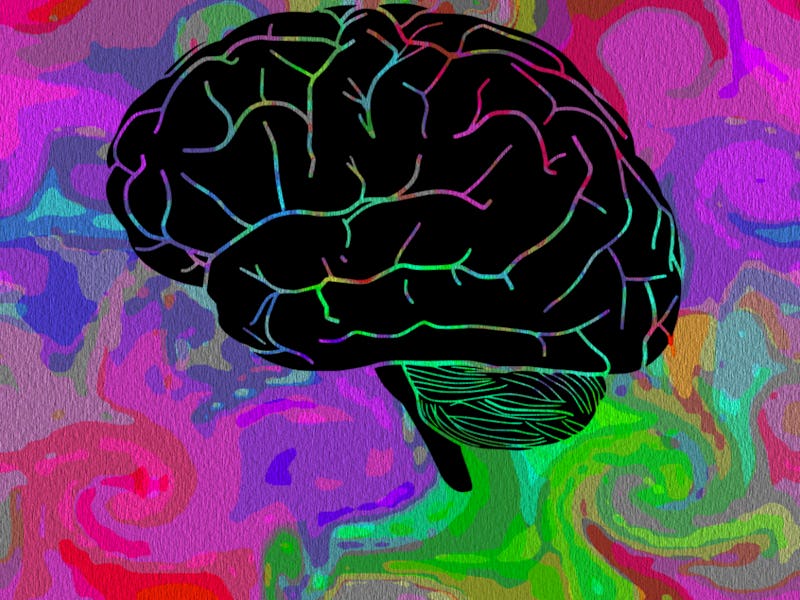Psychedelics Study Reveals the Strange Neuron Behavior Behind Hallucinations
When hallucinating, two subtle changes occur in the brain.

Hallucinations underlie many neurological conditions, drug-induced or otherwise. Narcolepsy, schizophrenia, and Alzheimer’s disease are all associated with moments when one visually perceives the unreal. Psychedelic drugs like LSD, of course, induce hallucinations as well. But despite how common they can be, scientists have been unable to explain the neural mechanisms that cause them. New research released Tuesday in Cell Reports is changing that.
In an effort to understand how individual neurons react during a hallucination, a team of researchers including University of Oregon associate professor of biology Cristopher Niell, Ph.D., gave mice hallucinogenic drugs and then looked at their brains.
The team expected to see neurons firing wildly and mismatched signals. Instead, they found that the drug caused a reduction of activity in the neurons of the visual cortex. Notably, says Niell, the information transmitted by these neurons didn’t change. During hallucination, the strength of those signals decreases, and their timing is altered.
Niell tells Inverse that either of these changes might contribute to the cause of hallucinations. Decreased signaling strength could cause parts of the brain areas to misinterpret the visual data collected through seeing, while altered timing could cause the data to be mis-transmitted to other parts of the brain.
These findings, Niell explains, provide insight into neurological and psychiatric disorders that result in disrupted perception and cognition, like schizophrenia.
“Eventually, we hope to put this all together to help understand in fine detail how the brain creates our representation of the world around us and how this is disrupted in altered states such as hallucinations,” he says.
The team gave their mice a hallucinogenic drug called DOI (2,5-dimethoxy-4-iodoamphetamine), which, like LSD and psilocybin, acts on serotonin 2A receptors. Unlike those drugs, it isn’t regulated by the Drug Enforcement Agency as a Schedule 1 drug.
After the dosing, the mice were shown images on a screen while the scientists measured the responses in their brains using fine imaging techniques.
Most studies on hallucinations have been performed on humans using methods like functional magnetic resonance imaging (fMRI). But these tests provide relatively low-resolution measures of brain activity across large regions of the brain. They give a sense that something in the brain is changing, but it’s hard to measure what individual neurons are doing, Niell says.
To study more closely the individual neurons involved in hallucination, the team took advantage of recent advances in microscopy and electrical recording. This, Niell says, “is like the difference between listening to the roar of a crowd in a stadium versus being able to hear the individual conversations of people within the crowd.”
In this way, they observed that the neurons of the hallucinating mice had alterations in the timing of neuron signals and a reduction in strength, despite the fact that overall brain signaling and activity in the visual cortex appeared the same as it did before the mice were on drugs. This demonstrates that the visual information processed in the brain isn’t different per se; it’s just the amplitude and timing of the signals that are changed.
Niell and his colleagues, who specialize in visual processing, argue that these results are in line with what we know about how the brain process visual information. When we see the world, we are seeing the brain’s interpretation of the visual data we absorb through out eyes. Hallucinations are what happens when the brain over-interprets and devalues that encoded information. Dreams are an analog for hallucinations: They too are vivid sequences of images we can process, despite a lack of actual visual signals.
Niell is careful to say that this study is primarily meant to spur further work. It’s a building block toward understanding hallucinations but doesn’t explain the phenomenon in its entirety. For one thing, while DOI acts as a hallucinogen in people and binds to the same serotonin receptors as all psychedelics do in mice, it can’t be said for certain what a mouse’s hallucination is like, limiting the study’s applicability to human brains. And while they observed changes in the hallucinating mouse brains, they can’t say what neural circuits are affected because the drug goes throughout the brain.
Nevertheless, the study is a step in the right direction: In light of the recent resurgence in the use of psychedelic drugs to treat mental health disorders, scientists are urgently trying to understand what happens when serotonin-2A receptors are altered and the brain hallucinates.
Summary:
Sensory perception arises from the integration of externally and internally driven representations of the world. Disrupted balance of these representations can lead to perceptual deficits and hallucinations. The serotonin-2A receptor (5-HT2AR) is associated with such perceptual alterations, both in its role in schizophrenia and in the action of hallucinogenic drugs. Despite this powerful influence on perception, relatively little is known about how serotonergic hallucinogens influence sensory processing in the neocortex. Using wide-field and two-photon calcium imaging and single-unit electrophysiology in awake mice, we find that administration of the hallucinogenic, selective 5-HT2AR agonist leads to a net reduction in visual response amplitude and surround suppression in the primary visual cortex, as well as disrupted temporal dynamics. However, basic retinotopic organization, tuning properties, and receptive field structure remain intact. Our results provide support for models of hallucinations in which reduced bottom-up sensory drive is a key factor in leading to altered perception.